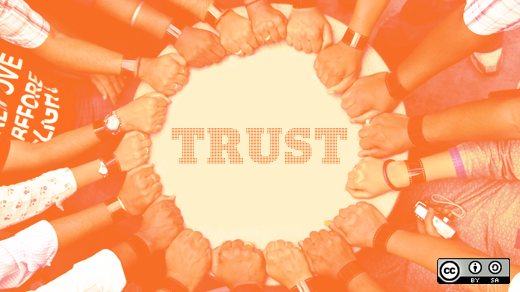When working to open up organizations or projects, I've learned that one of the most difficult things to do is to get people out of their comfort zones. We adults have spent a lifetime learning and refining our personal processes for productivity, creativity, and thoughtful exchange. One person's workflow might not work at all for someone else. We've learned that our workflows are highly personal, and I believe they are. However, in the case of "workflow," I see a massive difference between the terms "personal" and "private."
Let me explain that: Open means anyone can have a voice and get involved, but in order to truly encourage people to use their voices, the first thing they have to know is that they're being invited. We call this "designing for participation." A project or a community has to set up infrastructures, design workflows, and structure feedback to be that invitation all the time.
Producing a cultural shift (which is what "opening up an organization" really means) is about changing the trajectory and image of an organization so that it becomes more "open."
Culture is two things:
- A shared space and "the prevailing beliefs, values, and customs of a group; a group's way of life," and;
- What people do in that shared space, or "a set of practices that contain, transmit, or express ideas, values, habits, and behaviors between individuals and groups"; practices define organizational cultures.
Leaders must model the behavior they want to see in the world. So, in order to spark organizational change, leaders must start designing for participation.
Here's some practical steps you might take to design your team or project for participation.
Utilize existing structures
Email lists, Facebook pages/groups, newsletters, forums, corporate social networks—the people are somewhere, communicating already. You have to meet people where they are, so make a list and plan to utilize those structures. Use surveys and conversations to gather this information from people in your organizations. These should include questions like:
- How are you working together? What's a typical day look like for you?
- What tools do you use? What tools does your team use?
- What backchannels are you using?
- Where do you push information? Where do you pull information?
- What are your inside jokes? Favorite memes?
- What things are you loving this week?
Questions like these can help you demystify communication tactics.
Find an ally or three
Showing what open collaboration looks like is essential to creating cultural change. Remember: people are comfortable with what they're used to and change is essentially uncomfortable. Showing what the end goal—openness—looks like will inspire most people to invite change. However, in order to truly demonstrate open collaboration, you need collaborators! From the beginning, you're likely to find people who are excited to try something new. Artists, creatives and makers are usually accustomed to this kind of openness. Work with them, get them comfortable with being open, and then you'll have a posse of change agents.
Recognize personal flow
By getting to know your allies and how they prefer to work, you can set up methods that allow people to plan and publish openly. Encourage your allies to document, plan, publish—work—in a way that is suitable to them. Have open conversations to negotiate tools and processes, and leave the door open for renegotiation. If a tool isn't working for your team, find another one! You don't have to force the workflow; you just have to put the structures in place to allow work to flow. Test multiple collaboration tools.
Model, model, model
You can initiate cultural change by modeling behaviors. You and your posse need to model behaviors to establish trust. You can only control your own behaviors, so start implementing open practices: Plan openly (using an open, online task manager and open meetings), publish openly (using blogs and social media), evangelize openly (end posts with prompts for involvement), embed creativity and play (because play allows us to explore the impossible).
Plan in the open
Start meeting weekly with a conference call and an open planning document. Your agenda might include:
- Standups (what people are working on)
- Feedback
- Report outs (what people worked on last week)
- Demos and celebrations
Putting your plans into the open will help people feel ownership over projects. Think about using a wiki to keep an overview of team activity that includes goals, roles, deadlines and so on. Use a task manager so that everyone knows what's in process, where there are challenges, and what is actually happening. You can use documentation as part of your team process, thereby creating fodder for individual blog posts. Encouraging people to write public reflections on why an idea does or does not work; this way, you're designing a culture that invites feedback.
Publish in the open
To foster engagement and keep people posted, publish and share both individually and as a team. Setting a schedule is difficult, but you should try to publish at least one reflective post per month (I do one a week). Pre-populate tools like Tweetdeck or Hootsuite during meetings. Utilize tools like IFTTT, Zapier, Buffer, etc. There are easy ways to share ideas around the Web. Use them!
Evangelize in the open
Instead of thinking abstractly about engaging a global community of people, be nimble, try things out, have ideas and model open behaviors. Play and prototype and share loudly. As people begin to take notice, you'll have every opportunity to evangelize openly. Don't forget to highlight the rock stars in your community.
Reach out
Those of us who believe in the open organization are always willing to give advice and help out. Don't be afraid to reach out!
Follow the conversation on Twitter #theopenorg






2 Comments